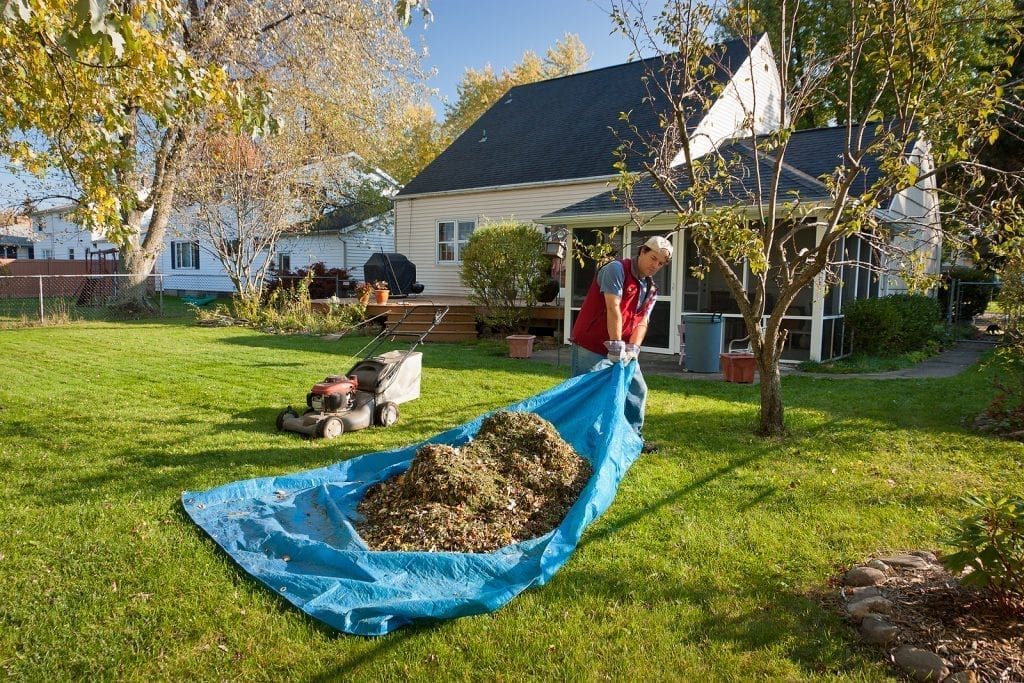What Steps Do I Need to Follow to Prepare My Lawn for Winter?

Winterizing your lawn will keep it healthy during the transition into and out of the cold months. If you understand how to winterize your lawn, you can have a healthy and thriving landscape.
It requires less effort and uses fewer inputs such as water, fertilizers, and chemicals for weed and lawn disease control. With a bit of prep, you can minimize your expenses. If you get ahead on work this season, you can lounge more and enjoy your property year-round.
Top smart steps to prepare your lawn for the winter
As is often the case, a little preparation and work in advance is easier and less expensive than reacting after you have a problem.
Especially, when it comes to your lawn.
Here are a few activities you can take part in this fall, to not only have grass ready for winter, but to ensure a great looking spring.
Step One – Mow your lawn throughout fall
Keep mowing your lawn in the fall until the last minute to shield it from the upcoming chilly weather.
Not leaving it too long will also help to create lawn diseases caused by fungi and bacteria. To be fair though, grass grows less quickly in the fall, so you won’t need to mow it as much. Follow your eyes.
The goal for your lawn is to have your grass trimmed to a height of approximately two and a half inches before the frost or snow begins to fall.
Step Two – Aerate your soil
Before winter approaches it is crucial that water, air and nutrients can be easily transported through your sod and into your soil. A desired tool will be one that slices into your soil with spikes or punches holes at intervals.
Cheap hand aerators can be purchased, but it is easier to rent a power tool for the day. Aim for a time when your soil is pliable and moist but not soaking wet and muddy.
Step Three – Fertilize your lawn
After a summer of being stressed by heat, insects and trampling feet, your lawn is starving for some nutrition. There is an opportunity for the grass to set new roots and thicken up in the next few months so it is the best time to fertilize.
Soil tests can often be obtained free through your county extension service, or at a garden center.
Depending on your soil test results, apply nitrogen, phosphorus and potassium at the appropriate amounts, using a spreader to achieve an even distribution. Using a compost is a naturally occurring renewable resource that enhances your lawn.
Step Four – Rake up debris and remove weeds
Do not allow leaves to smother your grass so rake frequently. Though it may be tempting to delay and do the job once, you’ll be putting stress on the grass below just when it needs to be thickening up for winter. Likewise, clear debris for the same purpose and watch out for weeds.
Hand weeding is labor intensive, but it will reduce the need for herbicides as you are physically pulling them out.
By winterizing your lawn in this manner your grass will not have to compete or struggle. But it can resurrect more strongly in the spring.
Step Five – Top-dress and overseed thin areas of grass
As part of your end of season lawn prep, you can sprinkle a layer of sand, topsoil, or compost on top of your grass to help thicken it up. Once again, a spreader makes this easy but a shovel can be used to manually spread the material.
At the beginning of fall cut the grass as short as you can. In places that are thin or damaged, add grass seed. Top dressing should be spread carefully from ¼ to ½ inch deep. Then complete the process by lightly watering it.
Step Six – Water lightly to help grass germinate
You may also want to consider making this part of your grass preparations for winter depending on your weather. If you’re getting rain regularly it won’t need the assistance but if you’re going weeks at a time without it your lawn will appreciate the help.
Watering is especially important in the case that you have done some overseeding on your lawn. Don’t wash out grass seed; use a delicate sprinkler. Reduce watering a couple of weeks before the first expected frost.
Step Seven – Maintain a good growing environment until the first hard freeze
Remember the previous tips and modify your lawn care accordingly before winter. You will see when it needs, or doesn’t, to rake fallen leaves, or cut or water the grass.
There is no single answer to preparing your lawn for winter and the best approach will depend on your property’s unique conditions. Continue with maintenance activities until the first hard frost causes the lawn to go dormant for the winter.
Additional ways to prepare your outdoor space for winter
You can apply these tips on prepping your lawn for winter to other areas of your yard. Planting perennials and spring blooming flowers. Inspect your shrubs and trees, prune dead portions, and feed as necessary.
Covering with mulch is a good winter storm prep for them as well, as it will protect their roots through the bitter days ahead and help provide even moisture for them through the coming season as well.
You insulate your house, why not insulate your plantings? Mulch is another natural and renewable soil amendment, similar to compost.
